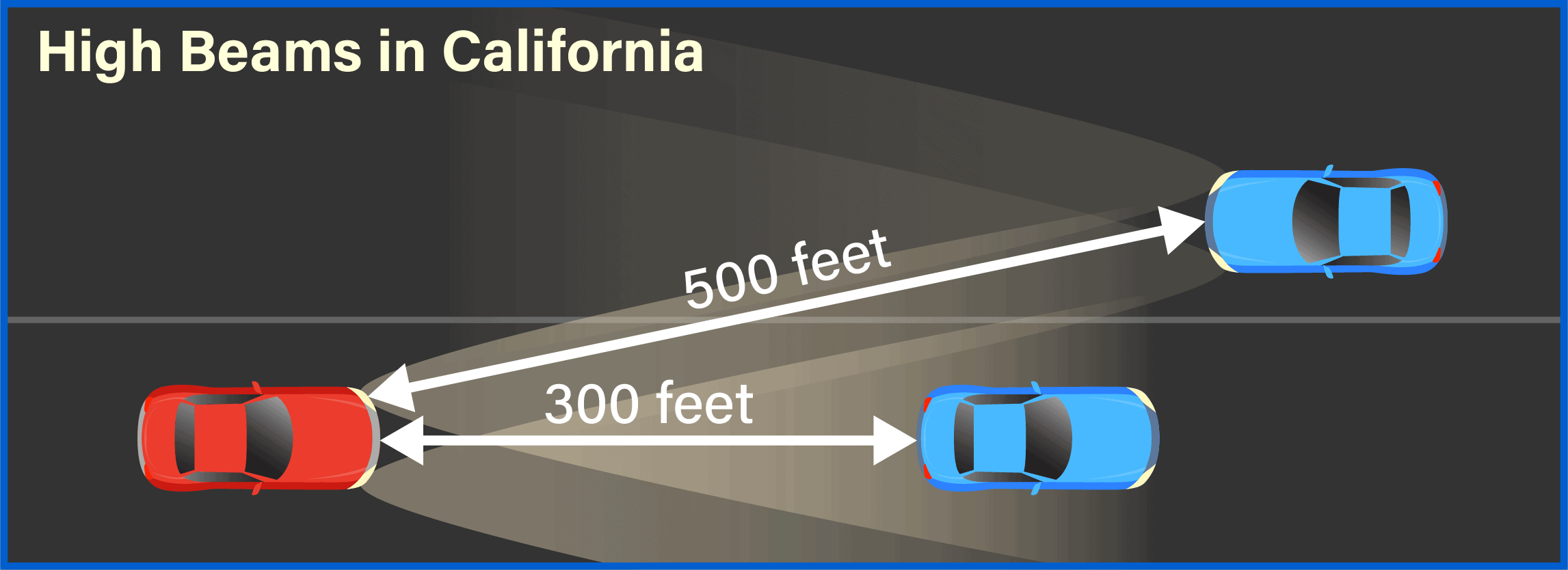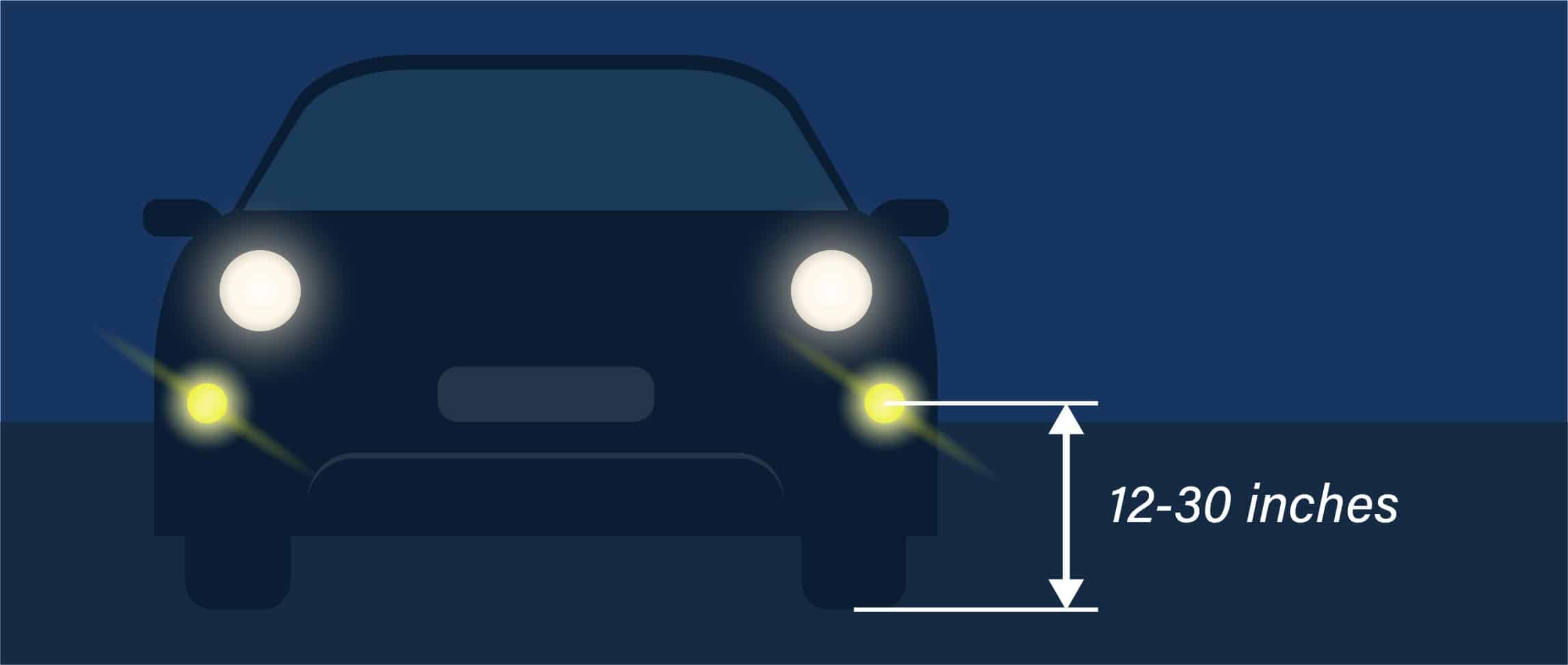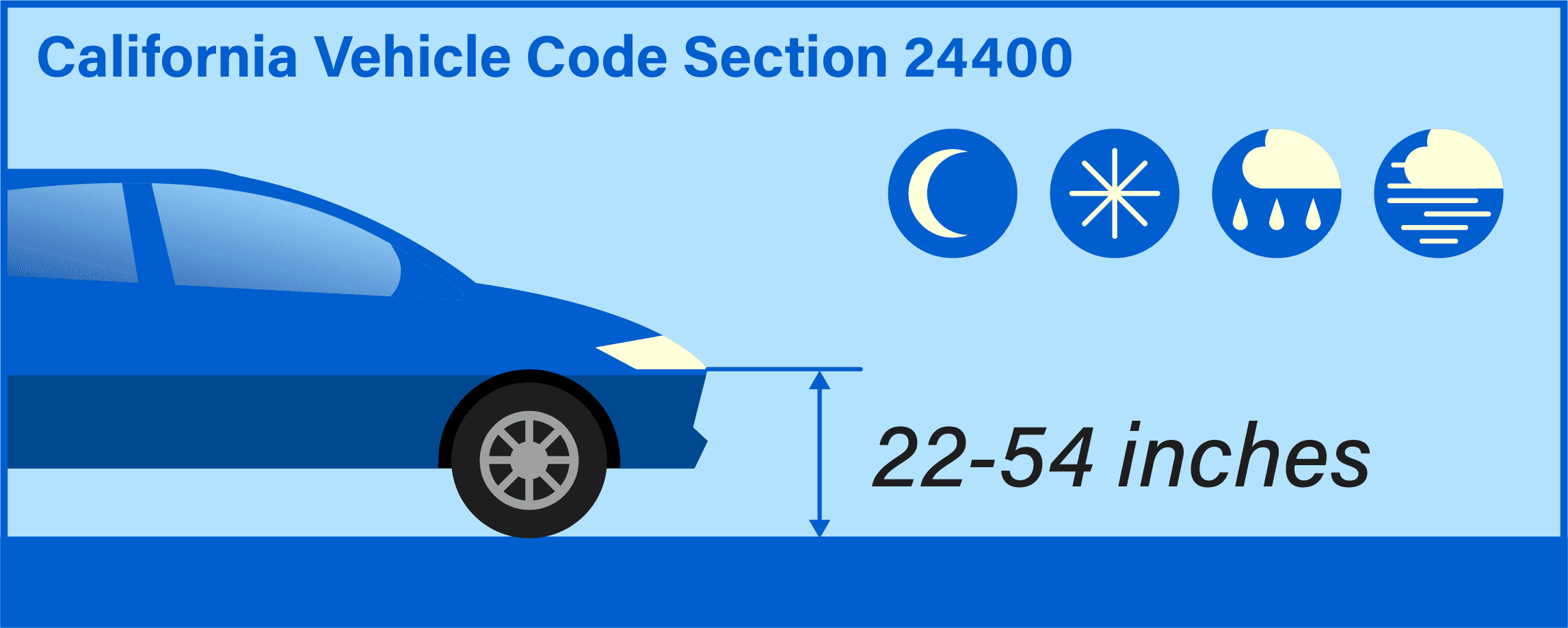California’s headlight law requires drivers to turn their headlights on in the dark and when the weather calls for it, such as in fog or heavy rain. This can help improve visibility and safety, and ensure that you can react quickly enough to road hazards. Let’s take a look at how and when to use your headlights to arrive safely at your destination – and comply with the law.
When Should You Drive with Your Headlights On?
According to California law, you must drive with your headlights on:
- Between Sunrise and Sunset: Headlights must be turned on from 30 minutes after sunset until 30 minutes before sunrise.
- During Inclement Weather: Headlights must be used during rain, fog, snow, or any inclement weather that affects visibility.
- When There Is Reduced Visibility: If you cannot clearly see a person or vehicle from a distance of 1,000 feet due to factors like dust or smoke, headlights are required.
- When the Windshield Wipers Are in Continuous Use: If the conditions require the use of your windshield wipers, headlights are required.
Traffic school can help you keep a clean driving record, prevent insurance increases, and more!
California Laws on High Beam Use

Section 24409 of the California Vehicle Code (CVC) allows high beams but only under certain circumstances:
- When there is no oncoming vehicle within a 500-foot radius.
- When the car you are following is more than 300 feet away.
- Except for these situations, you must turn off the high beams and use the low beams (your regular headlights).
The intensity of high beams can make it more difficult for other drivers to see, which poses a safety hazard. That’s why you should only use them when there are no vehicles around.
California Laws on Fog Light Use

Fog lights are positioned to cut through fog and improve visibility on the road. Section 24403 of the CVC allows their use if:
- Your car has no more than two fog lamps.
- You use them with, but not as a replacement for, headlamps.
- They are positioned in front of the vehicle at a height of 12 to 30 inches from the ground.
Depending on the weather conditions, you may turn on these lights when driving in fog, rain, or snow, as well as on dusty roads where visibility is limited. Their brightness can be a hazard for other motorists, so you shouldn’t use them unless it’s absolutely necessary.
California Headlight Law: Brightness, Color & More
In California, every car must have two headlights, one on each side of the front of the vehicle. These must meet other requirements in terms of color, height, and other characteristics.
Headlight Brightness in California
To prevent excessive glare, the maximum brightness of each headlight cannot exceed 2,513 lumens. That’s around four times more than the brightness of a 60-watt incandescent bulb, which has approximately 800 lumens. You can check the brightness of your bulbs by looking for a model or part number on the bulb. Use it to look up the manufacturer’s details. New bulbs will display the brightness on the packaging.
Headlight Color in California
CVC 25950 requires that the light emitted from a vehicle’s front headlamps be white or yellow. This regulation also applies to fog lights. The majority of headlamps sold today are white, but older cars may still have yellow headlights.
White or yellow headlights provide optimal visibility without excessive glare. They also cut through fog and rain more effectively than other colors. This reduces eye strain and improves road safety.
Headlight Height in California

According to CVC 24400, headlights must be positioned between 22 and 54 inches from the ground to ensure proper road illumination while reducing glare for other drivers. Most cars comply with these limits, but lifted trucks and SUVs as well as lowered sports cars could fall outside of these requirements.
LED Headlights in California
California law allows LED lights on vehicles as long as they meet the above requirements, such as a maximum brightness of 2,513 lumens. Aftermarket LED lights must be 5000k to 6000k, or a cool white.
To stay on the safe side, look for aftermarket LED headlights certified by the National Institute for Automotive Service Excellence (ASE) or approved by the Department of Transportation (DOT). Using illegal headlights can compromise your safety on the road and lead to hefty fines.
Headlight Tint in California
Most states, including California, prohibit headlight tinting. According to CVC 24400, a vehicle’s headlights must allow the driver to see other traffic participants from at least 1,000 feet. Tinting or other aftermarket modifications would not allow you to comply with this regulation.
Headlights for Motorcycles and Bicycles in California
Motorcycles in California must have at least one but no more than two headlamps. The lights must be in good working condition and automatically turn on when you start the engine.
Older motorcycles manufactured and registered before January 1, 1978, are exempt from these regulations, per CVC 25650.5.
Bicycles must be equipped with several lights to ensure 360-degree visibility when riding at night. These include:
- A front white light that’s visible from a distance of 300 feet when the bicycle is in motion.
- A red rear reflector or red light with a built-in reflector, visible from 500 feet when illuminated by a vehicle’s headlights
- A white or yellow reflector on each pedal, shoe, or ankle, visible from 200 feet in the front and rear.
- A white or yellow reflector on each side of the bike’s front half and a white or red reflector on each side of the rear — unless the bicycle has reflectorized tires.
If your bike doesn’t have a front white lamp, you may attach one to yourself (e.g., to a helmet) as long as it’s visible from 300 feet.
Broken Headlights
A vehicle’s headlights should be intact and functional at all times, even when they are not in use. Broken headlights can result in a “fix-it” ticket, fines, and points on your driving record.
With that in mind, replace your headlight bulbs at regular intervals or as soon as they begin to lose their brightness and dim. For reference, halogen bulbs have a lifespan of around 14 months, whereas LED bulbs last for 42 to 70 months.
Also, consider restoring your headlights to bring back their light efficiency. You can do this yourself with a professional kit or household products like vinegar, toothpaste, and baking soda.
Can You Get a Ticket for Violating California’s Headlight Law?

Yes, you can get a ticket for violating California’s headlight law. Driving with broken or illegal headlights or no headlights at all is an infraction.
The ticket carries a minimum fine of $238, plus administrative and court fees. It will also add one point to your record, which can lead to higher insurance premiums. These penalties also apply to drivers who misuse their headlights. Note that improper headlight usage could make you liable for an accident as well!
Complete Traffic School to Mask Your Ticket
If you didn’t cause an accident, you can reduce the impact of a headlight ticket by attending California traffic school. This allows you to mask one point on your driving record and prevent your insurance rates from rising.
With Best Online Traffic School, you can complete a self-paced, DMV-licensed course in as little as two to three hours, with 99.9% of students passing the final test on the first try. The course is available in English, Spanish, and Chinese and works on any device, including smartphones. Best Online Traffic School is available in all California counties, including Los Angeles, Riverside, and Orange county.
After passing, you’ll receive an electronic certificate of completion, which we’ll submit to the court and DMV the same day – ensuring your record stays clean.
Before signing up, make sure you’re eligible for traffic school. If you qualify, you can start for free and pay only after you pass.
Don’t let a headlight ticket raise your insurance rates – start traffic school for free today!
FAQs about California’s Headlight Law
Looking for more information about California’s headlight law? Below are the answers to some questions we get often.
Why does California have a daytime headlight law?
California drivers must use their headlights during the day if their windshield wipers are on, such as when it’s raining or snowing. This law also applies to certain stretches of highway.
Daytime headlights can improve visibility in adverse weather conditions. This can prevent accidents. They also make it easier for other drivers to see you. This can further reduce the odds of a crash.
Is it illegal to drive with one headlight in California?
Yes, it is. Any vehicle driving on California’s roads must have at least two functioning headlights.
Are 6000k headlights legal in California?
Yes, California law allows LED or HID headlights with a color temperature of up to 6000K. They must emit white light (not blue.)
Are pop-up headlights illegal in California?
California drivers may use pop-up headlights as long as they meet the state’s requirements in terms of brightness, positioning, and color.
However, very few cars nowadays have pop-up headlights. Most vehicle manufacturers no longer offer them because they are prone to electrical glitches.
